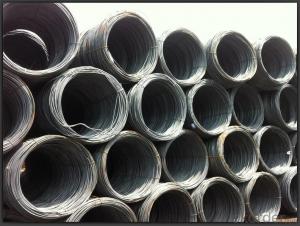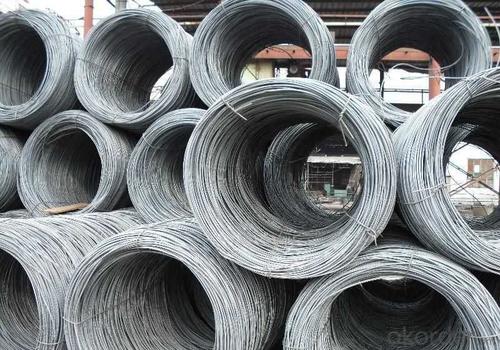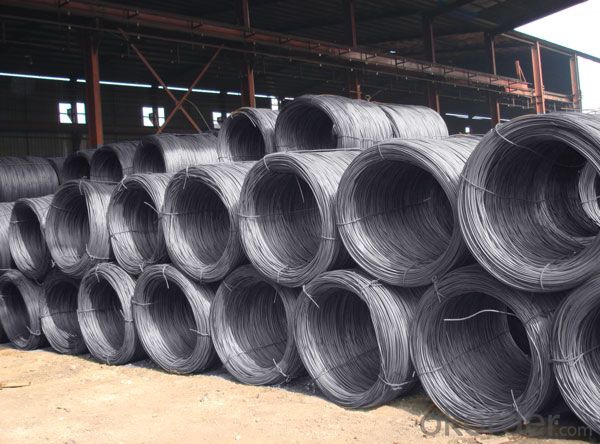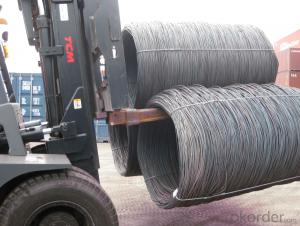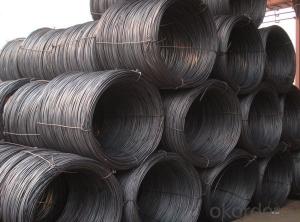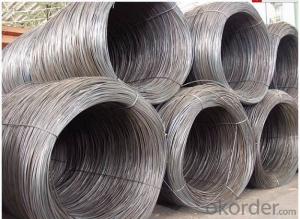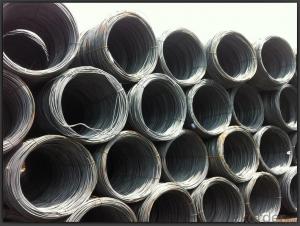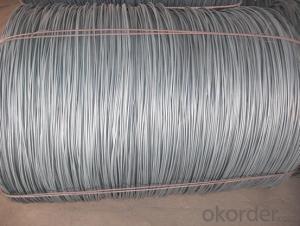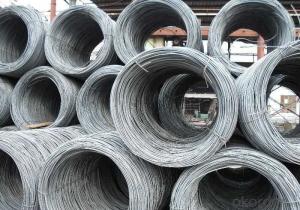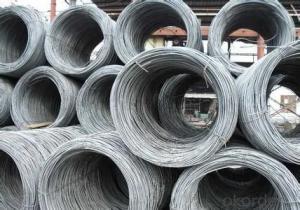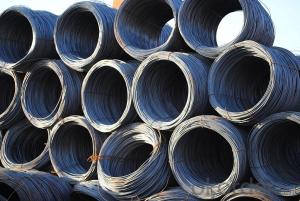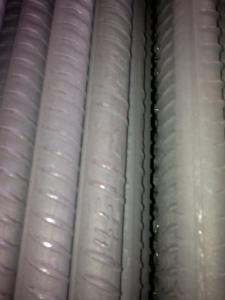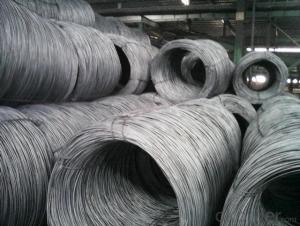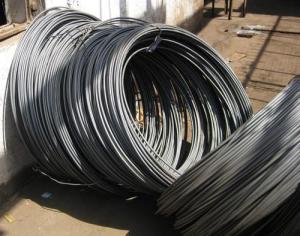Hot Rolled Steel Wire Rod SAE1006 5.5MM-14MM
- Loading Port:
- Tianjin
- Payment Terms:
- TT or LC
- Min Order Qty:
- 25 m.t.
- Supply Capability:
- 100000 m.t./month
OKorder Service Pledge
OKorder Financial Service
You Might Also Like
Product Description:
OKorder is offering high quality Hot Rolled Steel Wire Rod SAE1006 5.5MM-14MM at great prices with worldwide shipping. Our supplier is a world-class manufacturer of steel, with our products utilized the world over. OKorder annually supplies products to European, North American and Asian markets. We provide quotations within 24 hours of receiving an inquiry and guarantee competitive prices.
Product Applications:
After hot-rolled the products shaped into coil and delivery as finished product, including round, square, rectangular, hexagonal and so on. Since most of the products are round, it is generally called wire rod. Carbon steel wire rod is widely used in construction and manufacturing. Carbon steel wire rod is mainly used for reinforcement of reinforced concrete and welded structure or reprocessed (roberts , nail, etc.) materials, especially used to produce wire drawing, welding electrode, nails, spring, electronic, precise machinery parts and so on.
Product Advantages:
OKorder's Hot Rolled Steel Wire Rod SAE1006 5.5MM-14MMare durable, strong, and resist corrosion.
Main Product Features:
· Premium quality
· Prompt delivery & seaworthy packing (30 days after receiving deposit)
· Corrosion resistance
· Can be recycled and reused
· Mill test certification
· Professional Service
· Competitive pricing
Product Specifications:
Manufacture: Hot rolled
Grade: SAE1008 SAE 1006
Certificates: ISO, SGS, BV, CIQ
Diameter: 5.5mm, 6.5mm, 7mm,8mm,9mm,10mm,12mm,14mm, as per customer request
Packaging: Export packing, nude packing, bundled
Grade | Chemical Composition (%) | |||||
C | Mn | S | P | Si | B | |
SAE1008B | 0.10max | 0.32max | 0.045max | 0.040max | 0.30max | 0.0008min |
Mechanical properties | ||||||
Yield strength(N/mm2) | Tensile strength(N/mm2) | Elongation (%) | ||||
≥195 | 350-380 | ≥32 | ||||
FAQ:
Q1: Why buy Materials & Equipment from OKorder.com?
A1: All products offered byOKorder.com are carefully selected from China's most reliable manufacturing enterprises. Through its ISO certifications, OKorder.com adheres to the highest standards and a commitment to supply chain safety and customer satisfaction.
Q2: What makes stainless steel stainless?
A2: Stainless steel must contain at least 10.5 % chromium. It is this element that reacts with the oxygen in the air to form a complex chrome-oxide surface layer that is invisible but strong enough to prevent further oxygen from "staining" (rusting) the surface. Higher levels of chromium and the addition of other alloying elements such as nickel and molybdenum enhance this surface layer and improve the corrosion resistance of the stainless material.
Q3: Can stainless steel rust?
A3: Stainless does not "rust" as you think of regular steel rusting with a red oxide on the surface that flakes off. If you see red rust it is probably due to some iron particles that have contaminated the surface of the stainless steel and it is these iron particles that are rusting. Look at the source of the rusting and see if you can remove it from the surface.
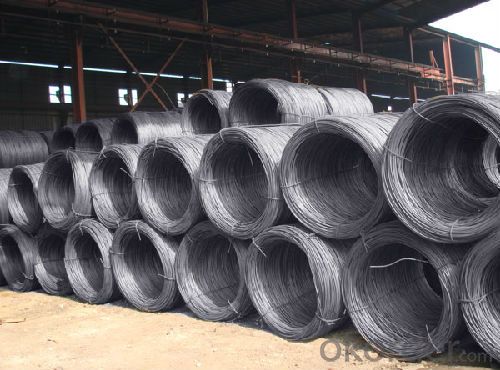
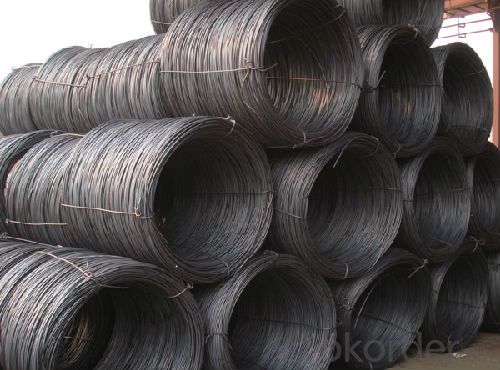
- Q: What are the different types of coatings used on steel wire rod?
- There are various types of coatings used on steel wire rods, each serving a specific purpose and providing unique benefits. Some common types of coatings include: 1. Zinc Coating: Zinc is one of the most widely used coatings for steel wire rods. It provides excellent corrosion resistance, acting as a protective barrier between the steel and the surrounding environment. Zinc coatings can be applied through hot-dip galvanizing or electroplating processes. 2. Polymer Coating: Polymer coatings are often applied to steel wire rods to enhance their durability and resistance to abrasion. These coatings can be made from various types of polymers, such as polyethylene or polypropylene, and are often applied through extrusion processes. 3. Phosphate Coating: Phosphate coatings are used to improve the adhesion between the steel wire rod and subsequent coatings or paints. They provide a rough surface that enhances the bonding ability of other coatings, thereby increasing their effectiveness. 4. Epoxy Coating: Epoxy coatings are commonly used for steel wire rods that will be exposed to harsh environments, such as marine or industrial applications. These coatings offer excellent chemical resistance and durability, protecting the steel from corrosion and other forms of degradation. 5. Chrome Coating: Chrome coatings provide a highly polished and decorative finish to steel wire rods. They are often used in applications where aesthetics are important, such as in the manufacturing of furniture or automotive components. 6. Nickel Coating: Nickel coatings are used to enhance the corrosion resistance of steel wire rods in highly corrosive environments, such as marine or chemical processing applications. Nickel coatings can be applied through electroplating processes. 7. Copper Coating: Copper coatings are applied to steel wire rods to improve their electrical conductivity. They are often used in applications where the wire rod will be used for electrical purposes, such as in wiring systems or electronic devices. It is important to note that the choice of coating for a steel wire rod will depend on the specific application and the desired properties of the finished product. Furthermore, some coatings can be combined or modified to achieve specific performance requirements.
- Q: How are steel wire rods used in the manufacturing of surgical instruments?
- Steel wire rods are an essential component in the manufacturing of surgical instruments due to their strength, durability, and flexibility. These rods are typically made from high-quality stainless steel, which offers excellent corrosion resistance and biocompatibility, making it ideal for medical applications. In the production of surgical instruments, steel wire rods are first selected based on specific requirements such as diameter, tensile strength, and composition. The rods are then subjected to a series of processes, including cutting, shaping, and bending, to form the desired instrument's structure. One common application of steel wire rods in surgical instruments is for creating the shaft or handle. These rods are often shaped into intricate patterns or designs to ensure a comfortable and ergonomic grip for surgeons. The high strength of steel wire rods allows the instruments to withstand repeated use, providing longevity and reliability. Another important use of steel wire rods is in the manufacturing of surgical needles. The rods are drawn down to the required diameter and then sharpened to create the needle's point. The flexibility of steel wire enables the needle to be easily maneuvered during surgical procedures, ensuring precise and accurate incisions. Moreover, steel wire rods can also be utilized in the construction of various surgical tools like forceps, retractors, and clamps. These instruments require a combination of strength and flexibility, which steel wire rods offer, allowing surgeons to perform delicate and intricate procedures with ease. Overall, steel wire rods play a vital role in the manufacturing of surgical instruments, providing the necessary strength, durability, and flexibility required for these essential medical tools. Their use ensures the quality and reliability of surgical instruments, contributing to the advancement of modern healthcare practices.
- Q: How is the microstructure of steel wire rod analyzed?
- The properties and quality of steel wire rod are examined through various techniques and methods in order to analyze its microstructure. Metallography, a common method, involves cutting and polishing a sample of the steel wire rod to create a flat and smooth surface. The prepared sample is then treated with a chemical solution to expose the microstructure when viewed under a microscope. Optical microscopy is frequently employed to study the microstructure of steel wire rod. It allows for the observation of different characteristics such as grain size, grain boundaries, and the presence of any impurities or flaws. This technique offers valuable insights into the quality and performance of the steel wire rod. Another widely used technique is scanning electron microscopy (SEM), which provides higher magnification and resolution compared to optical microscopy. SEM enables more detailed analysis of the microstructure, revealing surface morphology, grain boundaries, and the presence of precipitates or phases in the steel wire rod. Transmission electron microscopy (TEM), a more advanced technique, is utilized for analyzing the microstructure of steel wire rod. It involves the preparation of an extremely thin sample, typically less than 100 nanometers thick, which is then examined using an electron beam. TEM provides even higher resolution and can unveil the atomic structure, dislocations, and other intricate details of the microstructure. In addition to microscopy techniques, X-ray diffraction (XRD) and electron backscatter diffraction (EBSD) are also employed to analyze the microstructure of steel wire rod. XRD aids in identifying the crystallographic phases present in the steel wire rod, while EBSD provides information about crystal orientations and texture. In conclusion, the analysis of the microstructure of steel wire rod plays a crucial role in comprehending its mechanical properties, durability, and potential applications. These diverse techniques and methods enable researchers and manufacturers to evaluate the quality and ensure the desired microstructure for specific purposes.
- Q: What are the common defects found in steel wire rod?
- Some common defects found in steel wire rods include surface cracks, internal voids or inclusions, surface scratches or marks, uneven thickness, and improper chemical composition.
- Q: What are the common applications of carbon steel wire rod?
- Carbon steel wire rod has a wide range of applications due to its strength and versatility. Some common uses include construction materials, such as reinforcing concrete and manufacturing wire mesh; automotive parts, such as springs and wire cables; and industrial applications, such as welding electrodes and nails.
- Q: What are the major steel wire rod consuming countries?
- The major steel wire rod consuming countries include China, the United States, Japan, India, and South Korea.
- Q: How long is the shelf life of steel wire rod?
- The shelf life of steel wire rod is indefinite if stored properly.
- Q: What are the different types of steel wire rod heat treatments?
- There are several types of heat treatments for steel wire rod, including annealing, quenching and tempering, normalizing, and stress relieving.
- Q: What are the different types of steel wire rod surface cleaning tools?
- There are several different types of steel wire rod surface cleaning tools available in the market. These tools are designed to remove dirt, rust, and other contaminants from the surface of steel wire rods, ensuring a clean and smooth finish. One common type of cleaning tool is a wire brush. These brushes have stiff bristles made from steel or other materials that are capable of removing rust and loose debris from the surface of the wire rod. Wire brushes are available in various shapes and sizes, allowing users to choose the one that best fits their needs. Another type of cleaning tool is a sanding disc or wheel. These tools are typically made from abrasive materials such as sandpaper or grinding wheels. They are mounted on a rotating machine, and when pressed against the surface of the wire rod, they remove rust and other contaminants through abrasion. Chemical cleaning agents are also used to clean steel wire rod surfaces. These agents are usually applied using a brush or spray, and they work by breaking down and dissolving the contaminants on the surface. After application, the surface is usually rinsed with water to remove the cleaning agent and any remaining residue. Ultrasonic cleaners are another option for cleaning steel wire rod surfaces. These machines use high-frequency sound waves to create tiny bubbles in a cleaning solution. As the bubbles implode, they create a scrubbing action that removes dirt, rust, and other contaminants from the surface of the wire rod. In addition to these tools, there are also specialized cleaning machines available for larger-scale operations. These machines often use a combination of mechanical, chemical, and/or ultrasonic cleaning methods to ensure a thorough and efficient cleaning process. Overall, the choice of cleaning tool will depend on the specific needs and requirements of the user. It is important to consider factors such as the extent of contamination, the desired finish, and the size of the wire rod when selecting the appropriate cleaning tool.
- Q: How is steel wire rod used in the manufacturing of pre-stressed concrete?
- Steel wire rod is an essential component in the manufacturing of pre-stressed concrete. Pre-stressed concrete is a type of concrete that has been reinforced with steel cables or bars to enhance its structural strength and durability. Steel wire rod is commonly used as the primary material for producing these steel cables or bars. In the manufacturing process, steel wire rods are first drawn through a series of dies to reduce their diameter and increase their tensile strength. This process, known as cold drawing, results in a smooth and consistent wire with a high strength-to-weight ratio. The wire rod is then wound into coils for easy handling and transportation. To create pre-stressed concrete, the steel wire rod is further processed into strands or individual wires. These strands or wires are then embedded into the concrete structure before it sets. The steel wires are tensioned using hydraulic jacks, applying a force that is greater than the anticipated load the concrete will experience during its service life. This tensioning process helps to counteract the tensile stresses that concrete naturally experiences, making it more resistant to cracking and deformation. By incorporating steel wire rods into pre-stressed concrete, the overall strength and durability of the structure are significantly improved. The steel wires act as a reinforcement, providing additional strength to the concrete and allowing it to withstand higher loads and resist cracking. This is particularly useful in applications such as bridges, buildings, and other infrastructure projects where the concrete needs to bear heavy loads or endure challenging environmental conditions. Furthermore, pre-stressed concrete structures are more cost-effective compared to traditional reinforced concrete. The use of steel wire rod reduces the need for additional reinforcement, such as steel bars, resulting in a lighter and more efficient structure. The reduced weight also facilitates faster construction and lower transportation costs. In conclusion, steel wire rod plays a crucial role in the manufacturing of pre-stressed concrete. It is used to create steel cables or bars that are embedded in the concrete structure, enhancing its strength, durability, and load-bearing capacity. By incorporating steel wire rods, pre-stressed concrete structures can withstand higher loads, resist cracking, and provide cost-effective solutions for various construction projects.
Send your message to us
Hot Rolled Steel Wire Rod SAE1006 5.5MM-14MM
- Loading Port:
- Tianjin
- Payment Terms:
- TT or LC
- Min Order Qty:
- 25 m.t.
- Supply Capability:
- 100000 m.t./month
OKorder Service Pledge
OKorder Financial Service
Similar products
Hot products
Hot Searches
Related keywords


